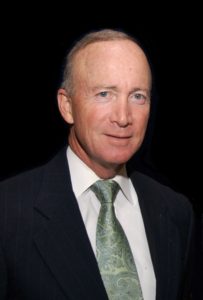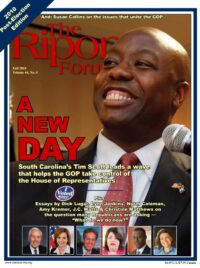
Will he or won’t he? That is the question on the minds of many Republican faithful desiring Mitch Daniels to throw his hat in the ring for the White House in 2012.
It will be another year before there is an answer to that question. But what makes Mitch (as he prefers to be called) such an attractive national candidate is his success in the only campaign that matters to him: restoring Indiana competitiveness.
When he took office in 2004, the state was $200 million in debt with a $700 million structural deficit. Six years later, the state enjoys a billion dollar surplus and the first two balanced budgets in nearly a decade. This success has not gone unnoticed. Standard and Poors awarded the state its first AAA bond rating, notably earned while neighboring states like Illinois were going bankrupt. This led Forbes Report to list the state #1 in the Midwest for business climate and numerous similar rankings have placed Indiana on the “best places to do business” map.
Governor Daniels achieved this remarkable turnaround by making fiscal discipline and managerial excellence his raison d’etre. Such behavior was not the result of a fad or to score political points, nor was it even a reaction to the severe distress his state was experiencing. Rather, running a tight ship is simply what makes Mitch Daniels, er, Mitch Daniels.
…in 2004, the state was $200 million in debt with a $700 million structural deficit. Six years later, the state enjoys a billion dollar surplus and the first two balanced budgets in nearly a decade.
As a former political director to Ronald Reagan and budget director for President Bush, Daniels could offer impressive Washington bona fides to a growing horde of national media paying visits to Indianapolis. Yet, he explains the best preparation for running a state came from the place he worked in between federal service: Eli Lilly & Co.
Daniels served as part of Lilly’s top brass, first as President of North American Operations and then as Senior Vice President for Corporate Strategy and Policy. He learned that every great business has a clear goal that employees can understand and embrace. Immediately upon election as governor, he made raising the state’s per capita income the State of Indiana, Inc.’s #1 goal. The new governor carefully explained to each of his agency heads that their success would be determined by how well their departments improved Hoosier salaries.
This jobs focus was easily applied to the newly formed cabinet-level economic development agency (see below) of course, but less obvious agencies had the same measuring stick. Take the EPA, for example. Governor Daniels did not ask the “enviros” to lessen standards in deference to business, but rather to simply expedite their rulings. Previous administrations allowed rulings to take over two years which caused great uncertainty and terrible delays in business operations. Daniels understood that business would benefit from quick ruling (up or down) and thus he required the EPA to report its progress in reducing lag time.
In order to build the “best sandbox in America” for business growth — the only sure route to increasing wages — the Daniels administration has fought on three fronts: getting the state’s fiscal house in order; reengineering government to operate at the speed of business; and building a 21st century infrastructure.
Getting Hoosiers’ Fiscal House in Order
The Daniels administration has cut over $250 million in unnecessary spending and saved another $190 million by privatization and renegotiating the previous administration’s contracts. This is simply the blocking and tackling of governing, albeit with a bit of flair. When asked by state bureaucrats for permission to build a new parking garage to house the expanding state fleet, Daniels had staff place a penny on the vehicles’ tires. When dozens of the cars still had the pennies months later, not only didn’t the agency get their garage but they were forced to sell the unused cars.
In order to build the “best sandbox in America” for business growth … the Daniels administration has fought on three fronts: getting the state’s fiscal house in order; reengineering government to operate at the speed of business; and building a 21st century infrastructure.
Reducing headcount is the surest route to reduced spending and sustainable budget management. Governor Daniels has cut staff to 1970s levels, yet surveys indicate improved customer service. To assist with the cost cutting effort, Daniels formed an Efficiency Commission and named some of the state’s leading private sector stars to fill its ranks. This is a simple and brilliant deployment of corporate talent in public service.
Act at the Speed of Business
As one of his first actions in office, Governor Daniels created the public-private Indiana Economic Development Corporation (IEDC) to bring jobs to the state. He installed himself as chairman and hired one of the state’s leading businessmen as director. He also hired the co-founder of Vera Bradley, one of the state’s great business success stories, to serve as head of the Commerce department.
This effort, and these leaders, insisted that the state would operate at the speed of business in pursuit of new jobs and attracting business from just across the state line as well as Asia and points between. In just its first year, IEDC completed more transactions than the previous two years combined and followed up the next year by becoming the only state in the nation to land three high profile automotive investments: Toyota, Honda and Cummins. The state is now seeking investments by automakers and others in its alternative energy sector.
Build a 21st Century Infrastructure
Daniels made national headlines when he sold a 75-year lease to operate state toll roads for an eye-popping $3.8 billion. While these funds are used for shovel-ready and long overdue roads and bridges projects, the Governor understands that the most important 21st century infrastructure investment is the education of Indiana’s children. Aided by new Republican majorities in both legislative chambers, look for Indiana to advance the nation’s most aggressive education reforms over the next two years.
During the last decade, Tommy Thompson and a crop of innovative GOP governors proved that some of the nation’s best policy innovation comes from the states. Mitch Daniels is adding a dynamic chapter to that story and his fiscal integrity campaign – and record of job creation – might very well lead to one more.
 Jay Hein is president of Sagamore Institute, an Indianapolis-based think tank. A senior White House official from August 2006 – August 2008, he also serves as Vice President of the Foundation for American Renewal and was appointed by Governor Daniels to serve as a member of the Indiana Commission on Community Service and Volunteerism.
Jay Hein is president of Sagamore Institute, an Indianapolis-based think tank. A senior White House official from August 2006 – August 2008, he also serves as Vice President of the Foundation for American Renewal and was appointed by Governor Daniels to serve as a member of the Indiana Commission on Community Service and Volunteerism.




